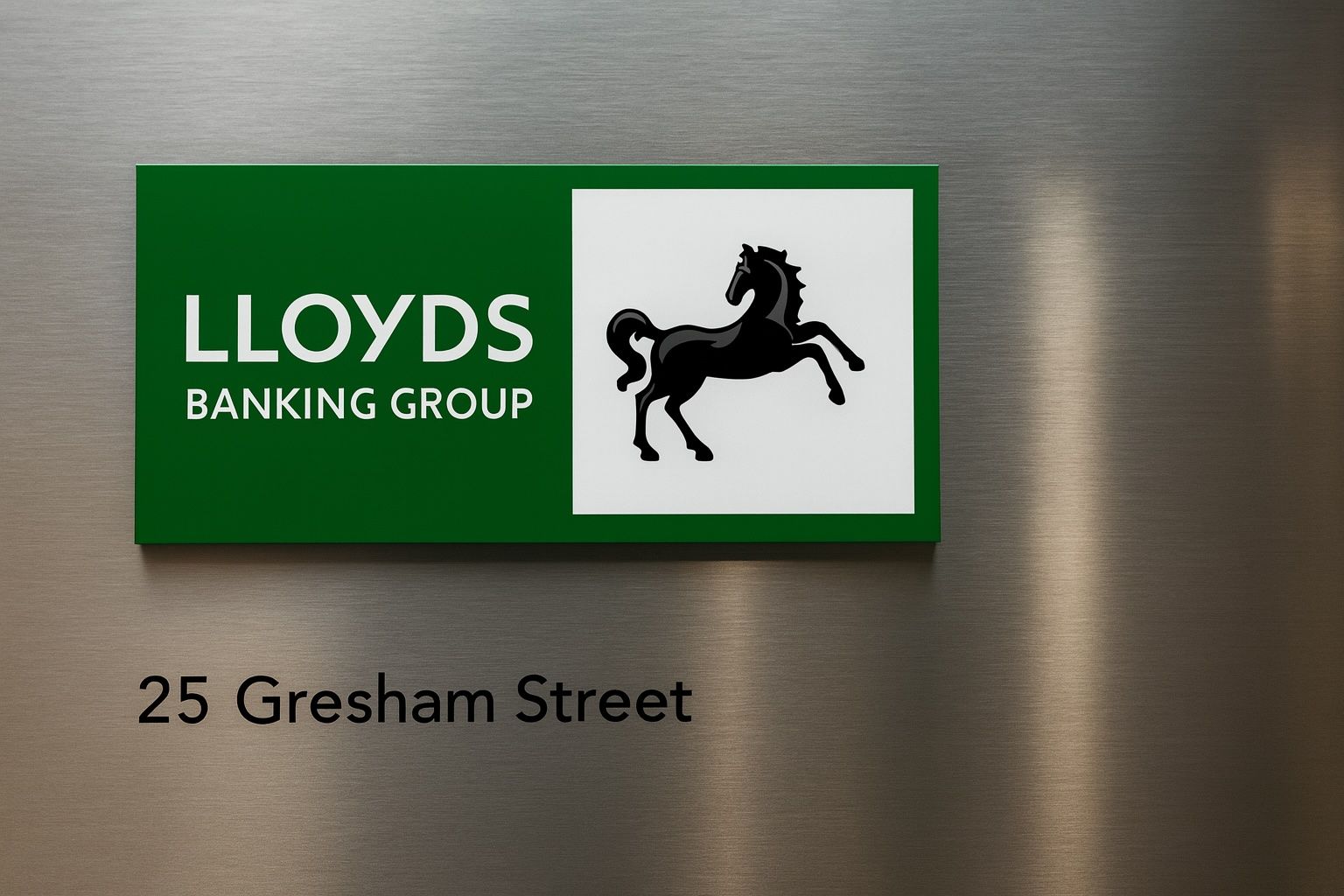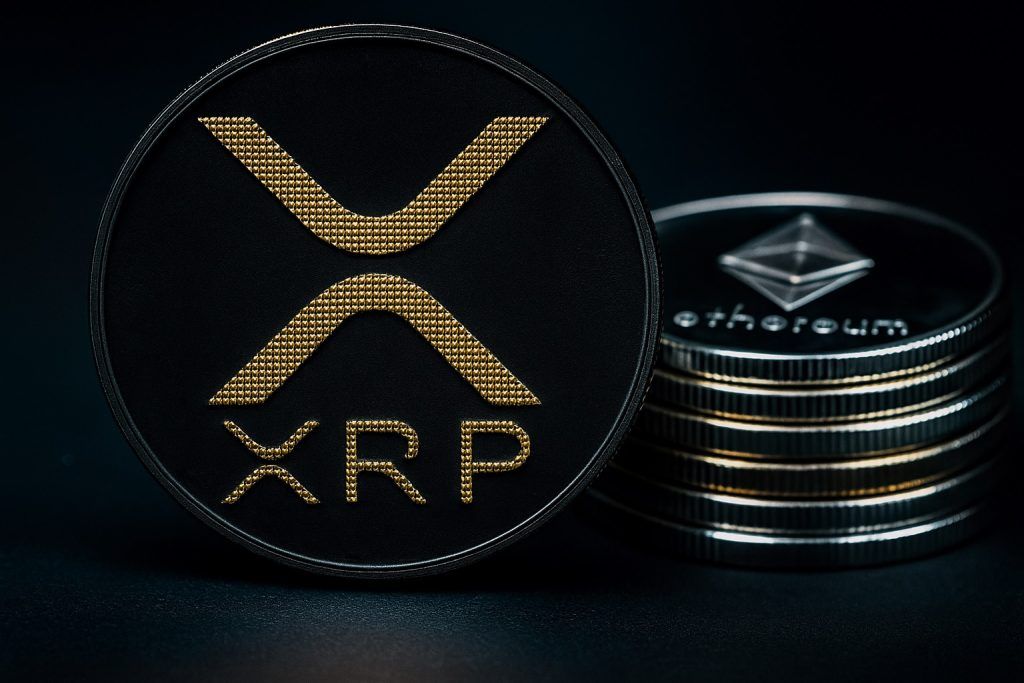Date: 20 November 2025
Location: London
Lloyds Banking Group’s share price is trading slightly higher this morning as markets continue to digest its controversial acquisition of fintech Curve, a steady stream of share buybacks, and shifting expectations for UK interest rates after inflation dropped to 3.6%.
Lloyds share price today: quick snapshot (LSE: LLOY)
By mid‑morning on Thursday 20 November 2025, Lloyds Banking Group (LSE: LLOY) was trading at 87.84p per share on the London Stock Exchange. That leaves the stock up about 0.25% on yesterday’s close of 87.62p. [1]
Key numbers from the London market (all in GBX, pence): [2]
- Last price: 87.84p
- Today’s move: +0.22p (+0.25%)
- Today’s range so far: 87.48p – 88.48p
- Open: 88.48p
- Previous close (19 November): 87.62p
- 52‑week range: 52.43p – 95.86p
- Distance from 52‑week high: ~8% below the 95.86p peak set on 12 November 2025
- 1‑year performance: +58.5%
- Market value: ~£52.6bn
- Trailing P/E ratio: about 13.5x
- Trailing dividend yield: ~3.7% based on annual dividends of roughly 3.3p per share
These prices are delayed by at least 15–20 minutes and can move quickly. Always check a live quote with your broker or trading platform before acting. [3]
Curve acquisition remains the main story
Lloyds’ share price today is still being driven by news that the bank has confirmed the acquisition of London-based digital wallet provider Curve, a deal first announced yesterday and now dominating payments and banking headlines. [4]
What is Curve and why does it matter?
Curve runs a digital wallet and card aggregation platform that lets users link multiple cards and funding sources into a single app, then choose how to pay—debit, credit, instalments, partner credit lines or even Open Banking links—on a transaction‑by‑transaction basis. [5]
For Lloyds, the deal potentially means:
- A step change in its digital wallet capabilities, going beyond a traditional current account app.
- The ability to launch more flexible products where customers switch past purchases between cards or instalment plans. [6]
- Extra customer perks, including stacked rewards on top of existing card benefits and reduced foreign‑exchange fees when spending abroad through the Curve wallet. [7]
The bank has not publicly disclosed a price, but multiple reports suggest Lloyds is paying close to £120m, significantly less than the roughly £250m Curve has raised from investors over its life. [8]
The transaction:
- Was announced formally on 19 November 2025, with Lloyds saying it does not expect a material impact on Group capital or its financial guidance for 2025 or 2026. [9]
- Is expected to complete in the first half of 2026, subject to regulatory approvals. [10]
Why is the Curve deal controversial?
The acquisition is not just a tech story; it has also turned into a governance and valuation row inside Curve’s shareholder base.
Finextra reports that IDC Ventures, Curve’s largest external investor with around 12% of the shares, has strongly criticised the deal. The firm alleges that a small group of directors and investors at Curve drove the sale at what they see as a depressed valuation, sidelining wider shareholder interests, and has warned that it “does not intend to support the proposed sale” while reserving legal rights. [11]
Despite that opposition, Lloyds has confirmed that it is proceeding, describing Curve as a strategic asset that strengthens its digital offering rather than a deal done for short‑term financial gain. [12]
Market commentary today and yesterday suggests that traders are still weighing: [13]
- The strategic upside of owning a modern, flexible wallet platform.
- The execution and reputational risk of buying into a disputed transaction with very public shareholder criticism.
- The fact that Lloyds is already heavily exposed to UK retail banking, so Curve adds tech and product depth rather than geographic diversification.
That mix of excitement and unease helps explain why LLOY has been volatile around the high‑80s pence level since the deal was unveiled. TechStock²+1
Share buybacks: over 10.7 million shares bought yesterday
Alongside the Curve news, Lloyds is continuing its large‑scale share buyback programme, another key pillar of the investment story in 2025.
In a regulatory filing covering trades on 19 November 2025, the bank disclosed that it bought back 10,783,182 ordinary shares on the market, at prices between roughly 87.5p and 89.0p per share, with a volume‑weighted average price of about 88.0p. All of these shares are to be cancelled. [14]
These purchases form part of the buyback programme first launched in February 2025, under which Lloyds has been steadily reducing its share count through the year. [15]
For shareholders, the buyback has several implications:
- It supports earnings per share (EPS), because future profits are spread over fewer shares.
- It effectively returns surplus capital to investors without raising the headline dividend too aggressively.
- It signals management confidence in Lloyds’ medium‑term profitability and balance sheet strength.
However, buybacks can also amplify volatility: when sentiment turns negative—such as when a controversial deal is announced—the company ends up buying more stock in a falling market, which attracts scrutiny. TS2 Tech, in an in‑depth piece on yesterday’s 1.6% drop in the share price, framed the day’s moves as a tug‑of‑war between digital expansion, capital returns and changing interest‑rate expectations. TechStock²+1
Strategic reshaping: Black Horse Offshore retreat and fraud‑focused initiatives
Black Horse Offshore pulls car loans from the Isle of Man
Today’s Lloyds headlines also include a regional reshuffle in its motor‑finance business.
Local station 3FM reports that Black Horse Offshore, a Lloyds subsidiary, will stop offering new car loans to customers on the Isle of Man, with other Crown Dependencies such as Jersey and Guernsey also affected. Existing customers will continue under their current contracts, but future lending will be offered through the Lloyds brand rather than Black Horse. [16]
On its own, this move is unlikely to shift the share price much. But it fits a broader pattern of Lloyds:
- Consolidating products under core brands.
- Streamlining smaller offshore operations.
- Focusing capital where returns and scale are stronger. TechStock²+1
Fighting fraud: data‑sharing and scam warnings
Two separate pieces today highlight Lloyds’ anti‑fraud agenda, an increasingly important theme for regulators, customers and investors alike:
- Jobseeker scam warning – Industry outlet The Global Recruiter reports a joint campaign by Get Safe Online, Lloyds Banking Group and JobsAware warning about a surge in employment scams ahead of the festive hiring season. Lloyds’ own data points to a 237% rise in “advanced fee” job scams since the start of the year, with more than half originating on social media, and an average loss of about £1,420 per victim. [17]
- Lloyds’ own fraud insight piece – On its website, Lloyds has published an article by its Fraud Director, Liz Ziegler, calling for much broader cross‑sector data‑sharing to tackle scams at source. The piece notes that fraud is now thought to account for over 40% of all crime in the UK, with estimates of more than £11bn lost to scamsin the 12 months to November 2024. The bank argues that real‑time data sharing between banks, tech platforms, telecoms and government could unlock up to £220m in extra resources by redirecting frozen criminal funds into prevention and victim support. [18]
For investors, these initiatives speak to reputational and regulatory risk management. The more Lloyds can position itself as proactive on fraud, the better placed it should be when regulators push for tougher consumer‑protection rules that might otherwise raise compliance costs or compensation risk.
Macro backdrop: inflation cools and rate‑cut bets rise
Today’s trading in Lloyds shares can’t be separated from the wider UK macro story. Yesterday’s inflation data showed that: [19]
- The Consumer Prices Index (CPI) rose 3.6% year‑on‑year in October 2025, down from 3.8% in September.
- It was the first fall in inflation in several months, driven mainly by slower increases in gas and electricity bills and weaker hotel prices, even as food inflation edged up to around 4.9%.
- UK inflation remains well above the Bank of England’s 2% target, but the trend is now clearly downwards.
Markets have reacted by ramping up bets that the Bank of England will cut rates at its next major decision on 18 December 2025, with some estimates putting the probability of a December cut at around 75–86%. [20]
This matters for Lloyds because:
- Lower rates are likely to squeeze net interest margins, especially after two years in which higher rates boosted UK banks’ profits.
- On the other hand, more accommodative policy can support borrowers and limit bad‑debt charges, which is crucial for a lender heavily focused on UK households and small businesses.
At the same time, markets are looking ahead to Chancellor Rachel Reeves’ Autumn Budget on 26 November 2025, with investors wary of possible tax changes affecting banks or their customers. [21]
Taken together, that mix of cooling inflation, looming fiscal decisions and likely rate cuts helps explain why Lloyds—despite a strong 12‑month run—is now trading a little below its recent highs as investors reassess the earnings outlook for 2026 and beyond.
After a 58% rally, is LLOY looking expensive or still cheap?
Valuation signals are mixed.
From the FT’s market data and recent analysis by independent research platforms: [22]
- Share price vs history: At around 88p, the stock is still up about 58% over the past year, but roughly 8% below its 52‑week high near 96p.
- Earnings multiple: Lloyds is trading on a trailing P/E of around 13–15x, somewhat above the typical 10–11x range often quoted for large UK banks.
- Dividend and capital returns: The trailing dividend yield of about 3.6–3.8%, combined with ongoing buybacks, provides a solid yield‑plus‑buyback story even as profits have been hit by motor‑finance redress provisions and other legacy issues. [23]
- Intrinsic value estimates: Some equity research models using “excess returns” methodologies still put fair value well above the current price, suggesting long‑term upside if Lloyds can deliver on its digital strategy and capital return plans. TechStock²
However, upside arguments are balanced by clear risks:
- Interest‑rate sensitivity: If the Bank of England cuts more quickly or more deeply than expected, Lloyds’ net interest margin could fall faster than consensus models assume. [24]
- Motor‑finance and consumer‑credit exposure: The bank has already taken sizeable provisions and continues to flag that regulatory and remediation costs in its motor‑finance book could remain material. [25]
- Curve execution risk: Integrating a fintech platform with governance disputes into a major bank, and turning that into profitable, at‑scale products, will take time and careful execution. [26]
What could move Lloyds share price next?
Looking ahead from today’s session on 20 November 2025, the main potential catalysts for LLOY include:
- Autumn Budget (26 November 2025)
- Any bank‑specific taxes, windfall measures or changes to the treatment of savings and investments could directly affect valuation and sentiment towards UK bank shares. [27]
- Bank of England decision (18 December 2025)
- A widely anticipated rate cut could pressure margins but support loan quality; markets will also scrutinise the Monetary Policy Committee’s guidance for 2026. [28]
- Further detail on Curve and digital strategy
- Investors will be looking for clarity on how Lloyds plans to monetise Curve, how it will be branded, and how quickly it can be integrated into existing mobile offerings. [29]
- Updates on buybacks and capital
- Any revision to the scale or pace of buybacks—or to the dividend policy—will be closely watched, particularly if credit conditions deteriorate or regulators take a tougher line. [30]
- Further fraud‑ and conduct‑related developments
- Lloyds’ growing role in national fraud‑prevention efforts could help its reputation, but any major scam or remediation story involving the bank would move the share price quickly. [31]
Bottom line for today, 20 November 2025
As of this morning, Lloyds share price is holding just under 90p, modestly higher on the day but still below its recent highs. The stock sits at the crossroads of three powerful themes:
- A headline‑grabbing digital wallet acquisition that could enhance its long‑term growth story but comes with governance controversy and integration risk. [32]
- Ongoing capital returns via sizeable buybacks and a solid dividend yield. [33]
- A shifting UK macro landscape, in which cooling inflation and a likely December rate cut could gradually reshape bank profitability from 2026 onwards. [34]
For traders, that backdrop suggests scope for short‑term volatility around macro data releases and Curve‑related headlines. For long‑term investors, the key question is whether Lloyds’ digital investments and disciplined capital returns can outweigh the pressure from lower interest rates and legacy issues in motor finance and consumer credit.
Important: This article is for information only and does not constitute investment advice or a recommendation to buy, sell or hold any security. Share prices can move quickly and may differ from the figures quoted above. Always do your own research and consider speaking to a regulated financial adviser before making investment decisions.
References
1. markets.ft.com, 2. markets.ft.com, 3. markets.ft.com, 4. www.lse.co.uk, 5. www.finextra.com, 6. www.finextra.com, 7. www.finextra.com, 8. www.finextra.com, 9. www.lse.co.uk, 10. www.marketscreener.com, 11. www.finextra.com, 12. www.finextra.com, 13. www.markets.iweb-sharedealing.co.uk, 14. www.tradingview.com, 15. www.directorstalkinterviews.com, 16. www.three.fm, 17. www.theglobalrecruiter.com, 18. www.lloydsbankinggroup.com, 19. www.ons.gov.uk, 20. www.moomoo.com, 21. www.pwc.co.uk, 22. markets.ft.com, 23. www.reuters.com, 24. www.ons.gov.uk, 25. www.reuters.com, 26. www.finextra.com, 27. www.pwc.co.uk, 28. moneyweek.com, 29. www.lse.co.uk, 30. www.tradingview.com, 31. www.lloydsbankinggroup.com, 32. www.finextra.com, 33. www.tradingview.com, 34. www.ons.gov.uk









